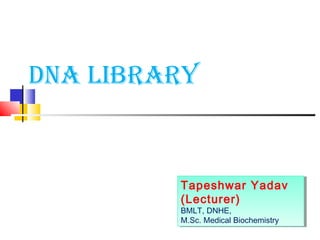
DNA LIBRARY AND GENE CLONING TECHNIQUES
- 1. DNA LIBRARY Tapeshwar Yadav (Lecturer) BMLT, DNHE, M.Sc. Medical Biochemistry Tapeshwar Yadav (Lecturer) BMLT, DNHE, M.Sc. Medical Biochemistry
- 2. DNA libraries or Gene Library A DNA library is a collection of cloned restriction fragments of the DNA of an organism. Two kinds of libraries will be discussed: genomic libraries and complementary DNA (cDNA) libraries. Genomic libraries ideally contain a copy of every DNA nucleotide sequence in the genome. In contrast, cDNA libraries contain those DNA sequences that appear as mRNA molecules, and these differ from one cell type to another.
- 3. 1.Genomic DNA libraries: A genomic library is the collection of fragments of dsDNA obtained by digestion of the total DNA of the organism with a restriction endonuclease and subsequent ligation to an appropriate vector. The recombinant DNA molecules are replicated within host bacteria.
- 4. Contd… The amplified DNA fragments represent the entire genome of the organism and are called a genomic library. Note: Cloned cDNA lack introns and the control regions of the genes, whereas these are present in genomic libraries.
- 6. 2.cDNA libraries: If a gene of interest is expressed at a very high level in a particular tissue, it is likely that the messenger RNA (mRNA) corresponding to that gene is also present at high concentrations in the cell. For example, reticulocyte mRNA is composed largely of molecules encoding the α-globin and β-globin chains of hemoglobin.
- 7. Contd… This mRNA can be used as a template to make a complementary dsDNA (cDNA) molecule using the enzyme reverse transcriptase The resulting cDNA is thus a double-stranded copy of mRNA. cDNA can be amplified by cloning or by the polymerase chain reaction.
- 8. Fig : Synthesis of cDNA from mRNA using reverse transcriptase.
- 9. Sequencing of cloned DNA fragments: The base sequence of DNA fragments that have been cloned and purified can be determined in the laboratory. The original procedure for this purpose was the Sanger dideoxy method illustrated in Figure. The ssDNA to be sequenced is used as the template for DNA synthesis by DNA polymerase. A radioactive primer complementary to the 3′-end of the target DNA is added, along with the four deoxyribonucleoside triphosphates (dNTP).
- 10. Contd….. The sample is divided into four reaction tubes, and a small amount of one of the four dideoxyribonucleoside triphosphates (ddNTP) is added to each tube. Because it contains no 3′-hydroxyl group, incorporation of a ddNTP into a newly synthesized strand terminates its elongation at that point.
- 11. Contd….. The products of this reaction then consist of a mixture of DNA strands of different lengths, each terminating at a specific base. Separation of the various DNA products by size using polyacrylamide gel electrophoresis, followed by autoradiography, yields a pattern of bands from which the DNA base sequence can be read.
- 14. Automated DNA sequencing: Modern automated DNA sequencing systems designed to generate over half a million bases of sequence per day use sequencing gels contained in multiple capillary tubes (rather than in a slab gel format). Preparation and loading of the samples onto the capillary gels is carried out by robots and data analysis is also automated.
- 15. Alkaline phosphatase Removes phosphate groups from 5' ends of DNA (prevents unwanted re-ligation of cut DNA) DNA ligase Joins compatible ends of DNA fragments (blunt/blunt or complementary cohesive ends). Uses ATP DNA polymerase I Synthesises DNA complementary to a DNA template in the 5'-to-3'direction. Starts from an oligonucleotide primer with a 3' OH end Exonuclease III Digests nucleotides progressiviely from a DNA strand in the 3' -to-5' direction Polynucleotide kinase Adds a phosphate group to the 5' end of double- or single-stranded DNA or RNA. Uses ATP RNase A Nuclease which digests RNA, not DNA Taq DNA polymerase Heat-stable DNA polymerase isolated from a thermostable microbe (Thermus aquaticus) ENZYMES USED IN MOLECULAR BIOLOGY
- 16. ENZYMES USED IN MOLECULAR BIOLOGY
